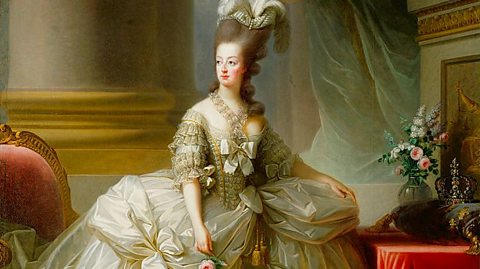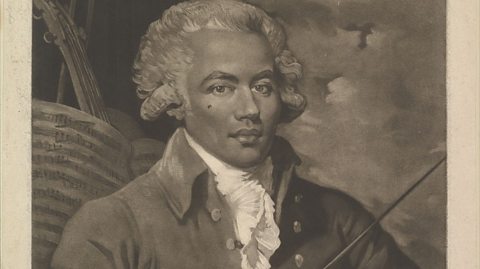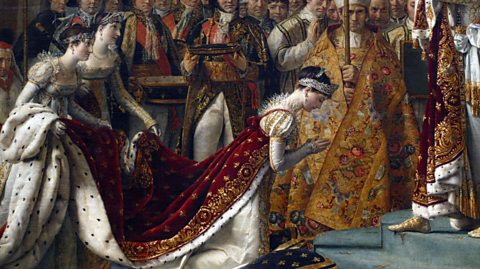Fashion, dance, controversy⊠what draws you to your favourite TikTok content creators?
Throughout history, people have accumulated fame and made headlines even without the aid of social media. Artists, fashion designers, musicians - you name it, there have always been followers spreading the word of talented people, and nowadays you can do it with the tap of a button. ±«Óătv Bitesize takes a look at four fabulous historical legends who we think would go viral today.

1. The influencer: Marie Antoinette
Trendsetter Queen Marie Antoinette would almost certainly be classed as an âinfluencerâ of her time in 18th Century France. With her dressmaker, Rose Bertin, Marie shaped fashion all over Europe. Rose created formal dresses for the queen, with ruffles and frills galore, suitable for court appearances. Marie was rumoured to have had 300 dresses made for her each year, and rumour has it she never wore anything twice.
While she might be criticised for her opulent clothes hauls nowadays in the movement against fast fashion, she would definitely be a viral media personality - though she still wouldnât actually say âLet them eat cakeâ. No doubt Rose would also have her fair share of followers from showing off her creations, as she was the needle and thread behind the controversial queenâs striking fashion.

2. The musician: Chevalier de Saint-Georges
A member of Marie Antoinetteâs court, Joseph Bologne (AKA the Chevalier de Saint-George) would also likely be a viral sensation today. Born on Christmas Day in 1745, Joseph was the son of white French plantation owner George Bologne and an enslaved Senegalese maid named Nanon. Unusual for an illegitimate mixed-heritage child, Joseph was given his aristocratic surname and his father was keen for him to receive an education in France. As a teenager Joseph defeated master fencers, but his true gifts lay in music: his skills on harpsichord and violin attracted the attention of high society. In 1776 he was proposed to be the conductor of the Paris Opera, but was ultimately denied as a person of colour. This didnât deter him. He was already the accomplished leader of the prestigious Concert des Amateurs, where he excelled in a contemporary style called Symphonie Concertante. In this style, two violin soloists would compete - like a rap battle with strings.
He is sometimes referred to as the âblack Mozartâ, but many historians consider this an unfair comparison as he was actually a contemporary of Mozart and was a lot more famous in Paris and the rest of Europe during his active years.
Unfortunately when Napoleon took power in 1804, shortly after Josephâs death, he reinstated slavery in the French colonies and attempted to erase the Chevalier from history by banning his music. But the tireless efforts of French Afro-Caribbean communities, as well as those in Guadeloupe where he was born, have ensured his work is not forgotten today. In other words, Josephâs epic violin-offs have endured turbulent times and would certainly make the rounds on social media today under the hashtag #BlackExcellence.

3. The artist: Michelangelo
You watch a TikTok of someone starting an intriguing piece of art⊠and see itâs part one of 34, uploaded in daily instalments. Grr! Still, you just need to persevere to see the finished result.
For Renaissance artist, sculptor, architect and poet Michelangelo, his four-part series (four years, that is) would be his magnum opus: the ceiling of the Sistine Chapel in Rome, completed in 1512. And not without some petty drama: artistic rivals Raphael and Bramante apparently hoped he would give up, as he was more accustomed to sculpting than painting. But Michelangelo rose to the challenge - quite literally on a platform, painting 12,000 sq ft (around 1,114mÂČ) of Painting and sketching directly into fresh (wet) plaster. on his back. Though it was considered an astounding technical feat, he also dealt with his fair share of haters - even 25 years later when Michelangelo was in his 60s, Biagio da Cesena, the papal master of ceremonies, kept complaining to Pope Julius II that the nudity wasnât suitable for the chapel. As revenge, Michelangelo painted Biagoâs likeness into the new Last Judgement fresco as the devil Minos.
Talent and drama are definitely elements of a trending TikToker. And yes, we bet he would get lots of views by splitting his updates into multiple parts to keep you coming back to his account. Worth it!

4. The dancer: Marie Taglioni
A new TikTok dance takes the schoolyard by storm seemingly every five minutes - but this dancer set a trend so major it changed the ballet landscape forever. First we must go back: before Romantic ballets, the dance was quite different. It was ballerino-orientated and acrobatic, sometimes even with whole acting parts which didnât dance. It was in the 1830s that this began to change.
Swedish-Italian ballerina Marie Taglioni had to work hard to impress her father Fillipo Taglioni, a ballet master, fighting against a natural inward curve of her back. She developed a style which showed off delicate shapes and form rather than athletic tricks and pirouettes.
Before pointe shoes were perfected in the 1890s to fit Russian ballet legend Anna Pavlova, going up en pointe was a technical stunt rather than the aesthetic standard we see today. Taglioni played a huge part in changing this: performing in the ballet La Sylphide - a ballet about a Scottish An elemental air spirit from medieval folklore. that Fillipo created for her - she glided on her toes to make her performance as light and fairy-like as possible. Audiences fell in love with this style and pointe work became typical.
Taglioni had a huge amount of followers even without social media to show off her dance - she and contemporaries such as Fanny Elssler sparked a fanatic period known as âthe cult of the ballerinaâ. While no one is sure if itâs true, an enduring rumour is that one group of From the French ballet + -mane, loosely translating to âballet enthusiastâ. were such big fans that they purchased Marieâs ballet slippers for 1000 rubles, to then be cooked in a stew served with champagne. Hmm! Fans aside, we think Taglioni would be creating dance challenges to take the internet by storm today.
This article was published in June 2023
Regency era fashion trends that persisted
From dresses to accessories, we look at four Regency fashion fads.

Famous books that changed their titles
Read the stories behind these famous name changes.

Four history-making journeys youâve never heard of
±«Óătv Bitesize takes a look at some of these incredible journeys and the people who embarked on them.
